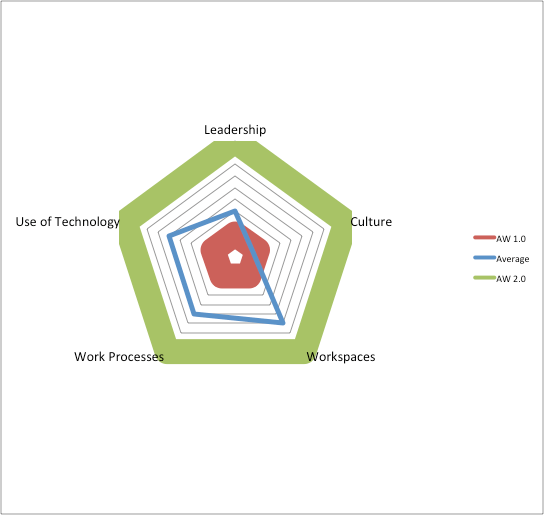 Some organisations believe they have ‘done’ Agile Working. They have increased the ratio of people to desks and achieved a saving in accommodation costs. They have provided flexible working arrangements across the organisation and have enabled their people to work at home for part of their working week. Staff surveys show employees are pleased with the opportunities and benefits this provides them. But organisations cannot afford to become comfortable or complacent, there are greater opportunities to grasp. As in any transformation initiative, Agile Working is more than a project it is a cultural journey involving continuing change to achieve continuous improvement. Agile Working is moving on.
Some organisations believe they have ‘done’ Agile Working. They have increased the ratio of people to desks and achieved a saving in accommodation costs. They have provided flexible working arrangements across the organisation and have enabled their people to work at home for part of their working week. Staff surveys show employees are pleased with the opportunities and benefits this provides them. But organisations cannot afford to become comfortable or complacent, there are greater opportunities to grasp. As in any transformation initiative, Agile Working is more than a project it is a cultural journey involving continuing change to achieve continuous improvement. Agile Working is moving on.
We have found in our assessment of organisations that the more enterprising are reaching a second stage on the journey – we are calling Agile Working 2.0. By adopting Agile Working 2.0 organisations are seeking a more positive culture creating a change ready environment enabling them to take advantage of the opportunities and benefits that will be available in the next dynamic decade. HR, IT and FM still have important roles to play but new ways of working are now becoming central to the core business of organisations. Agile Working 2.0 means we need to think, work, and manage differently.
Agile Working 2.0 has five components:
1. Agility – Agile Working 2.0 subsumes the techniques and approaches developed in agile software development within new ways of working to emerge as an all-pervasive agility organisational culture.
2. Digital Workspace – Organisations need to offer workspaces, digital and physical, that cater for a fluid workforce with high expectations of mobility, flexibility and wellbeing.
3. Dynamic universal work styles are replacing rigid departmental ones. They enable and support people to find the best way of achieving their potential.
4. Resilience – The international standard, ISO 22316, defines organisational resilience as the ability of an organisation to absorb and adapt in a changing environment. When practised effectively Agile Working enables employees to be more resilient through proactive behaviours, which in turn makes their employers more resilient organisations.
5. Collaborative working – employees can achieve more by working in virtual teams across departmental boundaries. The enabling technology is available now but work processes need to catch up.
The current state of play
Agile Working as it was, Agile Working 1.0, has been mainly focussed on hot desking, working from home, mobile working technologies and changing a culture from presenteeism to management by results. Of course, not every organisation has reached this stage. In our assessments we have found a significant number of organisations that are struggling with embedding an Agile Working culture. The chart (right) shows a typical situation.

We have developed an assessment tool to benchmark where an organisation is on their Agile Working journey. The following questions are some that we use to determine if an organisation has progressed beyond the first stage and is embarked on the second stage of the Agile Working journey.
By reflecting on the following questions (below) you can determine if your organisation has progressed beyond stage one and is embarked on the second stage of the Agile Working journey.
Workspaces
• Are the new worksettings that have been provided for different work activities being used as intended or, in reality, are people using the same favoured locations regardless of the activities they are undertaking?
• Has the organisation and its people actively embraced coworking locations away from their office base and home?
• Are worksettings allocated on the basis of individual workstyles or standard ratios?
Work Processes
• Have new processes been developed to take advantage of improvement opportunities of Agile Working or are the processes in use essentially the same but just being done at a wider range of times and locations?
• Are the original workstyles and work activities being reviewed and developed and have people been reassigned as their work capabilities and job roles change?
• Has the contribution of Agile Working to the organisation’s resilience been assessed?
Use of Technology
• Have you moved beyond providing laptops and tablets to introducing a concept of a workspace with a “work from anywhere” mind-set by providing all the digital resources that people need to get their work done?
• Is the organisation exploiting conferencing and collaborative technologies to replace a range of face-to-face meetings? If these are available are these technologies just used for progress meetings and catch up calls?
• Are opportunities for AI such as productivity apps and voice control being evaluated?
Culture
• Have your employees moved on from work-life balance where employees’ time is strictly separated between work and non-work activities to adopting Work-life integration (where employees feel the autonomy to readily switch between these activities working outside normal working hours to fulfil urgent business commitments)?
• Are Agile Working policies in place that promote, agility, trust and empowerment rather than set the conditions for practising Flexible Working?
• Can your organisation readily attract and retain talent from generations X and Y?
Leadership
• Is the leadership team actively reinforcing the organisation’s vision for Agile Working?
• Do directors’ behaviours and unwritten ground rules demonstrate a commitment to Agile Working?
• Are managers empowering their teams, taking account of different personality types, or are some managers still uncomfortable at managing staff they cannot see sat at their desks?
If you can honestly answer yes to most of the questions above your organisation is well on the way to reaching Agile Working 2.0. If not, you are still in the foothills of the Agile Working journey and there is much more to be done.
__________________________________________________
 John Eary is the author of a new book, Agile Working and the Digital Workspace. He is a Director of JEC Professional Services, a consultancy with a strong track record in providing advice and support on Agile Working and exploiting IT effectively. John has assisted over 30 organisations adopt new ways of working. John is a regular blogger on agile working and seeks to provoke thinking on the opportunities and challenges for new ways of working presented by technology. John regards himself as a true agile worker practising work-life integration.
John Eary is the author of a new book, Agile Working and the Digital Workspace. He is a Director of JEC Professional Services, a consultancy with a strong track record in providing advice and support on Agile Working and exploiting IT effectively. John has assisted over 30 organisations adopt new ways of working. John is a regular blogger on agile working and seeks to provoke thinking on the opportunities and challenges for new ways of working presented by technology. John regards himself as a true agile worker practising work-life integration.
 Paul Allsopp is Managing Director and Principal Consultant of The Agile Organisation. A Member of the Workplace Change Organisation with wide-ranging property and workplace knowledge, experience and successful track record gained in corporate workplace departments and management consultancy. He previously headed the BT Agile Working Programme, developed and managed implementation of the BT 21st Century Office and Workplace Strategy and was responsible for delivering the award-winning BT Workstyle 2000 Programme in UK Provinces.
Paul Allsopp is Managing Director and Principal Consultant of The Agile Organisation. A Member of the Workplace Change Organisation with wide-ranging property and workplace knowledge, experience and successful track record gained in corporate workplace departments and management consultancy. He previously headed the BT Agile Working Programme, developed and managed implementation of the BT 21st Century Office and Workplace Strategy and was responsible for delivering the award-winning BT Workstyle 2000 Programme in UK Provinces.














November 15, 2018
Are you ready for the world of agile working we will experience in the 2020s?
by John Eary and Paul Allsopp • Comment, Facilities management, Workplace design
We have found in our assessment of organisations that the more enterprising are reaching a second stage on the journey – we are calling Agile Working 2.0. By adopting Agile Working 2.0 organisations are seeking a more positive culture creating a change ready environment enabling them to take advantage of the opportunities and benefits that will be available in the next dynamic decade. HR, IT and FM still have important roles to play but new ways of working are now becoming central to the core business of organisations. Agile Working 2.0 means we need to think, work, and manage differently.
Agile Working 2.0 has five components:
1. Agility – Agile Working 2.0 subsumes the techniques and approaches developed in agile software development within new ways of working to emerge as an all-pervasive agility organisational culture.
2. Digital Workspace – Organisations need to offer workspaces, digital and physical, that cater for a fluid workforce with high expectations of mobility, flexibility and wellbeing.
3. Dynamic universal work styles are replacing rigid departmental ones. They enable and support people to find the best way of achieving their potential.
4. Resilience – The international standard, ISO 22316, defines organisational resilience as the ability of an organisation to absorb and adapt in a changing environment. When practised effectively Agile Working enables employees to be more resilient through proactive behaviours, which in turn makes their employers more resilient organisations.
5. Collaborative working – employees can achieve more by working in virtual teams across departmental boundaries. The enabling technology is available now but work processes need to catch up.
The current state of play
Agile Working as it was, Agile Working 1.0, has been mainly focussed on hot desking, working from home, mobile working technologies and changing a culture from presenteeism to management by results. Of course, not every organisation has reached this stage. In our assessments we have found a significant number of organisations that are struggling with embedding an Agile Working culture. The chart (right) shows a typical situation.
We have developed an assessment tool to benchmark where an organisation is on their Agile Working journey. The following questions are some that we use to determine if an organisation has progressed beyond the first stage and is embarked on the second stage of the Agile Working journey.
By reflecting on the following questions (below) you can determine if your organisation has progressed beyond stage one and is embarked on the second stage of the Agile Working journey.
Workspaces
• Are the new worksettings that have been provided for different work activities being used as intended or, in reality, are people using the same favoured locations regardless of the activities they are undertaking?
• Has the organisation and its people actively embraced coworking locations away from their office base and home?
• Are worksettings allocated on the basis of individual workstyles or standard ratios?
Work Processes
• Have new processes been developed to take advantage of improvement opportunities of Agile Working or are the processes in use essentially the same but just being done at a wider range of times and locations?
• Are the original workstyles and work activities being reviewed and developed and have people been reassigned as their work capabilities and job roles change?
• Has the contribution of Agile Working to the organisation’s resilience been assessed?
Use of Technology
• Have you moved beyond providing laptops and tablets to introducing a concept of a workspace with a “work from anywhere” mind-set by providing all the digital resources that people need to get their work done?
• Is the organisation exploiting conferencing and collaborative technologies to replace a range of face-to-face meetings? If these are available are these technologies just used for progress meetings and catch up calls?
• Are opportunities for AI such as productivity apps and voice control being evaluated?
Culture
• Have your employees moved on from work-life balance where employees’ time is strictly separated between work and non-work activities to adopting Work-life integration (where employees feel the autonomy to readily switch between these activities working outside normal working hours to fulfil urgent business commitments)?
• Are Agile Working policies in place that promote, agility, trust and empowerment rather than set the conditions for practising Flexible Working?
• Can your organisation readily attract and retain talent from generations X and Y?
Leadership
• Is the leadership team actively reinforcing the organisation’s vision for Agile Working?
• Do directors’ behaviours and unwritten ground rules demonstrate a commitment to Agile Working?
• Are managers empowering their teams, taking account of different personality types, or are some managers still uncomfortable at managing staff they cannot see sat at their desks?
If you can honestly answer yes to most of the questions above your organisation is well on the way to reaching Agile Working 2.0. If not, you are still in the foothills of the Agile Working journey and there is much more to be done.
__________________________________________________